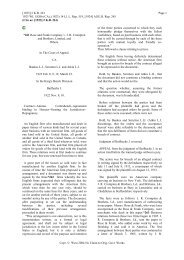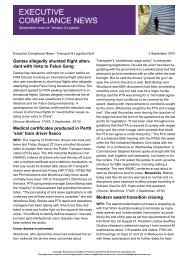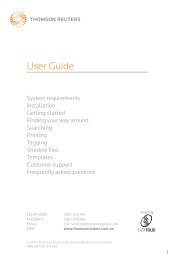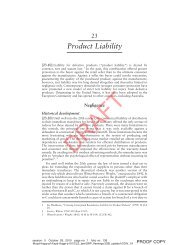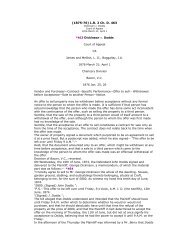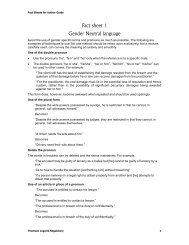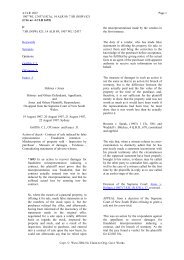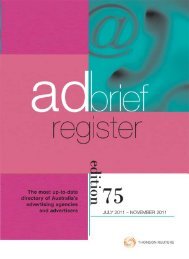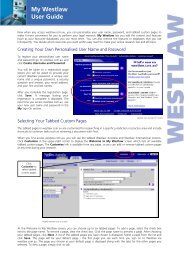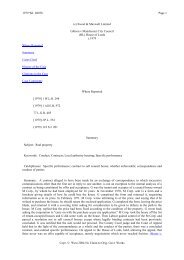Tesco v Constain - Thomson Reuters
Tesco v Constain - Thomson Reuters
Tesco v Constain - Thomson Reuters
You also want an ePaper? Increase the reach of your titles
YUMPU automatically turns print PDFs into web optimized ePapers that Google loves.
2003 WL 21729349 Page 742003 WL 21729349 (QBD (T&CC)), [2003] EWHC 1487(Publication page references are not available for this document.)on a number of occasions. In 1977 proceedingswere commenced in which it was alleged that thecauses of the flooding were the negligent design bythe defendants of the drains serving the church halland the omission from the design of a damp proofcourse. The defendants contended that the cause ofaction of the claimants had accrued when thechurch hall had been constructed and thus that itwas statute-barred by the date of thecommencement of the action. The trial judgerejected that contention and the defendantsappealed. The leading judgment was that of RalphGibson LJ. At page 22 of the report he said:--"I can see no relevant difference between therelationship of the defendant consulting engineersin the Pirelli case to their clients, the plaintiffs, andthe relationship of the defendant architects in thiscase to their clients, the United Reformed Churchof East Finchley. In both cases there was negligentdesign which was latent, in the sense that for a timethe building and the various parts of it functionedas those parts were expected and required tofunction, and which was later the cause of physicaldamage to the building. I therefore conclude that,unless this case can be distinguished on the facts insome way from the Pirelli case or unless it fallswithin an exception from the rule established bythat case, the cause of action in respect of thenegligent design of the drains must be held to haveaccrued when the flooding occurred and notbefore."245. A little later in his judgment, at page 23G-J,Ralph Gibson LJ said this:--"In applying the principle established in thePirelli case, as Judge Stabb sought to do intheTozer Kemsley case, I see no reason why on thefacts of a particular case the defect resulting fromnegligent design or supervision should notconstitute the physical damage to the buildingprovided that the damaging consequences of thedefect are immediately effective. In suchcircumstances there is no need for subsequent orlater damage in order to complete the cause ofaction.Accepting the principles stated by Judge Stabband applying them to the facts of this case, I amunable to find that the defect in design can orshould be treated as physical damage to thebuilding. The drains, in the physical conditionresulting from the defect in design, were not suchas to produce at once their damaging effects. Theywere capable of functioning properly as drains andthey did so for some twenty months. When theyfailed effectively to function as drains because ofheavy rainfall in the area they did not merelyfunction unsatisfactorily, e.g. by making noises oremitting smells, but were the cause of physicaldamage to other parts of the building. The defect indesign in this case was, in my judgment, as latent,and as distinct from subsequent physical damagecaused by it, as was the negligent incorporation ofunsuitable material in Pirelli's chimney."246. At page 25A-D of the report Ralph GibsonLJ considered an alternative argument on behalf ofthe defendants:--"Next counsel for the defendants submitted that,if the design defect in the drains cannot in this casebe treated as physical damage, nevertheless itcaused, at the date of practical completion at latest,economic damage to the plaintiffs, i.e. the burdenof the cost of putting the drains in order. As I havesaid, counsel for the defendants in this caserepeated the argument which he presented to theHouse of Lords in the Pirelli case based on twocases of breach of duty by solicitors, Howell v.Young (1826) 5 B & C 259 and HForster v. Outred& Co (a firm) [1982] 2 All ER 753, [1982] 1 WLR86. I have already set out Lord Fraser's commenton that argument: in his view the submission wasnot well founded. Counsel for the plaintiffs hasobjected that the point was not taken below andthat no evidence was directed towards it. Counselfor the defendants accepts that that is the position.Even if nevertheless the point can be regarded asopen to the defendants on this appeal, for my part Iam of the opinion that it cannot avail thedefendants so as to require that the cause of actionbe treated as having accrued at latest on practicalcompletion. The ordinary relationship of client andarchitect which existed between the parties in thiscase, or of client and consulting engineer whichwas present in the Pirelli case, is not in my viewsuch that liability for pure economic loss wouldarise in tort on proof of negligent design orsupervision but without proof of damage toproperty."The rejection by Ralph Gibson LJ of the analysisthat a defect in a building which had not causeddamage to person or property did give rise toeconomic loss and his view that an architect orconsulting engineer did not owe a duty of care intort the scope of which could extend to not causingeconomic loss to his client do not reflect the way inwhich the law in this area has developed.247. The second strand of authority to which Ihave referred may be considered for presentpurposes as commencing with the decision of theHCourt of Appeal in Forster v. Outred & Co. [1982]1 WLR 86. In that case a lady executed a legalcharge over her home in February 1973 to secureloans to be made to her son. The defendantsolicitors acted for her in relation to the executionof the legal charge and did not advise her as to riskswhich she was assuming by entering into thecharge. A demand was made under the charge inCopr. © West 2004 No Claim to Orig. Govt. Works



